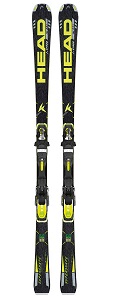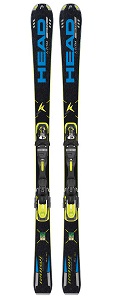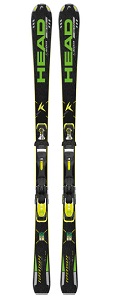![]()
Head has hit the spot with these three models. In the absence of more models to test (willing to have more on future editions), our general impression on Head skis is the brand is thinking how to offer a fun and good product that fulfills people’s expectations. And that is a very positive point for them. However, this ends up very distorted due to the marketing strategy they’ve chosen.
Since the skis became “intelligent”, it is now possible to speak out whatever insanity comes to our minds for explaining how good skis from any brand behave. The inclusion of a vulgar imitation of a chip in the serigraphy is the cornerstone (and pinnacle) of the “intelligence” concept. I searched for a port to connect an electronic device but I didn’t find any in the three tested models. Which is quite intriguing since they all include an evocative “i.” in their names. However, chances were I wasn’t looking in the right manner. I didn’t lose the hope to understand what the “intelligence” concept was all about. So I headed for their website eager to find some information about the chip. For example: clock speed, cache memory, architecture (is it a RISC processor?) ram memory, etc. I ended up quite frustrated because I couldn’t find any fact related to the chip. But suddenly I realised the “intelligence” concept worked flawlessly. It is hard to admit, but to be honest I must say Head “intelligent” skis are smarter and more clever than me. The problem was me, not the skis.
The next pilar where Head’s marketing stands upon is the KERS, which is the recursive acronym for Kinetic Energy Recovery System. Don’t lose the opportunity of reading the manufacturer’s explanation about this technology. Those who are curious by nature can visit Wikipedia. You will find it’s nothing remotely similar to what Heads claims.
In summary, Head collects concepts from other fields and apply those ideas into their marketing for selling their products. And I say selling and not building on purpose. Because not having found what kind of materials they use to generate, store and manage those electrical charges, how are they transmitted, what kind of chip, what is the supplier company for the chips, how are they programmed (computing language), the voltage, and a quite large etcetera, drives me to think those ideas are just based on commercial purposes and lack any actual technical base. Maybe it’s just that I am an evil-minded person. But despite that, I am sure many of you will agree with me when I say Head could explain themselves much better.
Let’s see how these tested skis behave, because sincerely, that’s their best argument. Why? Because they work, and they work very good at the same time they are targeted to a very specific profile.
A common characteristic to the three tested models when skiing is some degree of disconnection from the tip. This sensation fades away as soon as we slightly move forward our upper body and we decide to pilot the skis instead of just skiing them. This shouldn’t be understood as something negative. The majority of skiers won’t notice this disconnection feeling. That’s because they really slide into the turns very easily. And the progressiveness in how each arc of the curve happens conveys into a controlled and safety feeling.
The flex pattern is medium and can even be qualified as medium-soft in the Speed model. But this is not against having a powerful reactivity. The three models bring back whatever we’ve set on them during the turn quite strongly. It is relatively easy to be skyrocketed at will. If we are decided to pilot these skis, the fun is guaranteed. The more “on-piste short turn” focused is the Speed model. The Titan has a similar touch, but its wideness gives it a clear advantage on non groomed terrain. The Magnum will give us the most widened turn (although it lacks a Giant Slalom touch and feel), and it is the most demanding of the three.
If any drawback should be pointed out, it is how specific they are. They are brilliant at their profiles, but polyvalence is not significant at all.
Design
Sober, flat, simple as a stone, and just a bit spurred by a reminder of the eighties look that seems to be catching on again. This is the summary. Beginning at the tip, the size of the brand’s name “HEAD” covers a more than significant portion. It is big, very big. Those letters have one or another eye-catching color depending on the model, and even at a remarkable distance we will be able to distinguish between them. Many will be delighted, but for those who prefer more refined designs it will probably be seen as a hassle. They are placed above the serigraphy’s background, which is black.
All models mount Tyrolia bindings and are exactly the same found in other brands. Tyrolia’s reputation is beyond doubt. But they look insipid nowadays. If a decade ago their design was roundy and a bit puffed, looking heavy and well designed at the time, now they’ve been slimmed down in a way the snow is very happy to find a couple of new holes to fill. They come painted in different combinations. Basically in black with some color notes such as fluorescent green, for example. I’d have preferred gold flashes on a black background.
© Copyright – All rights reserved

 Head iSupershape Speed
Head iSupershape Speed Head iSupershape Titan
Head iSupershape Titan Head iSupershape Magnum (updated to 2014-2015)
Head iSupershape Magnum (updated to 2014-2015)